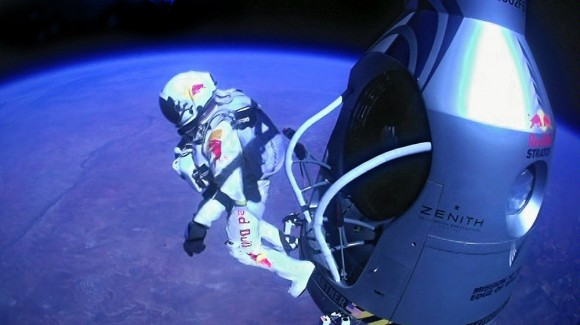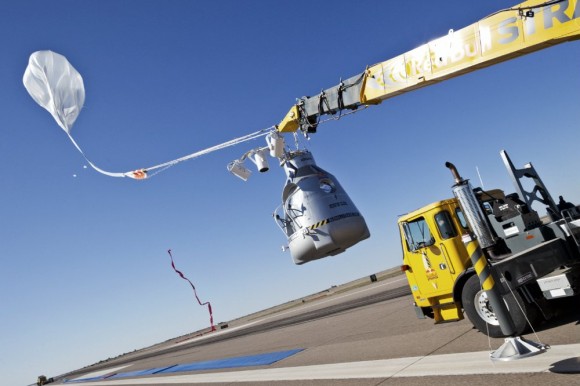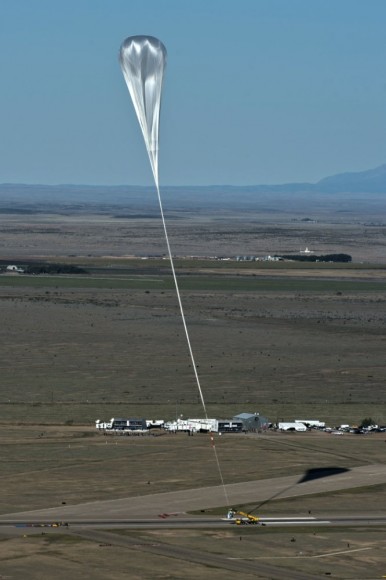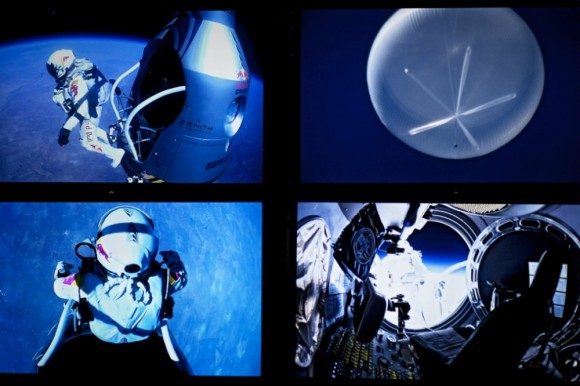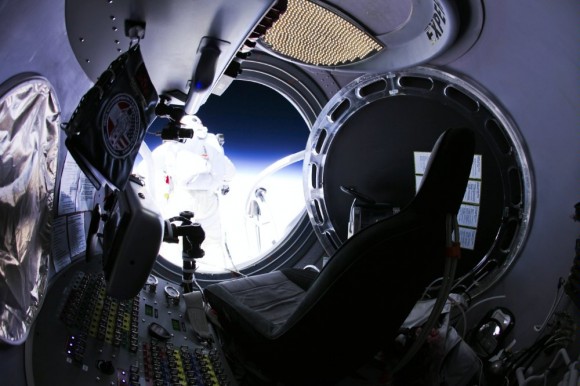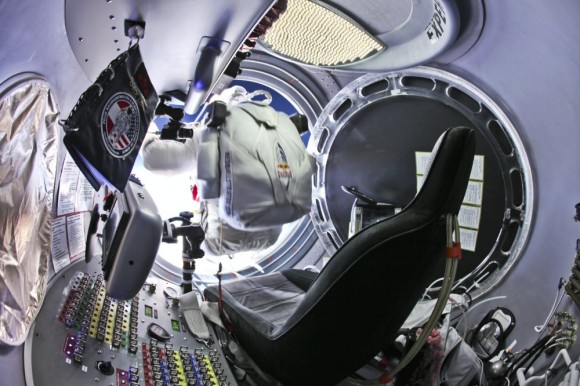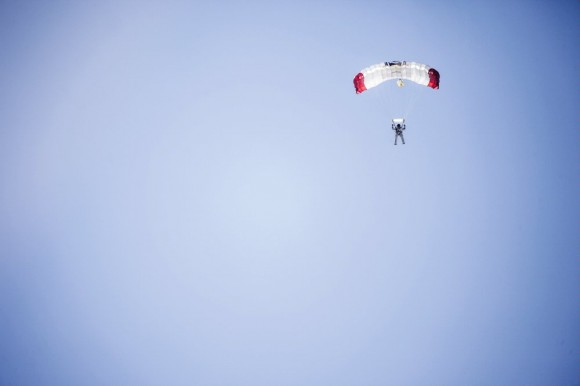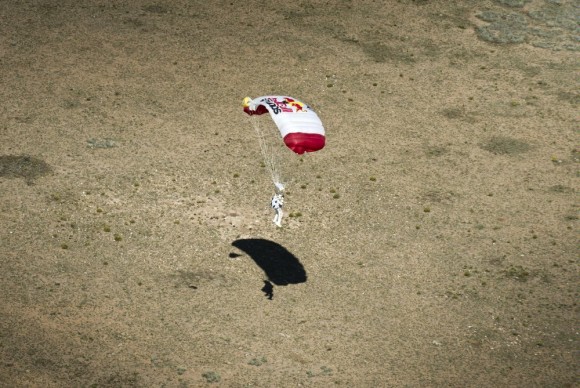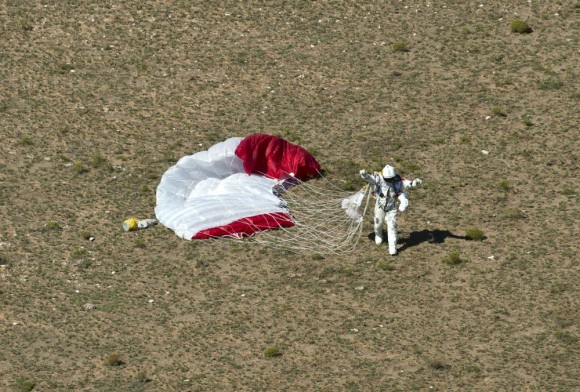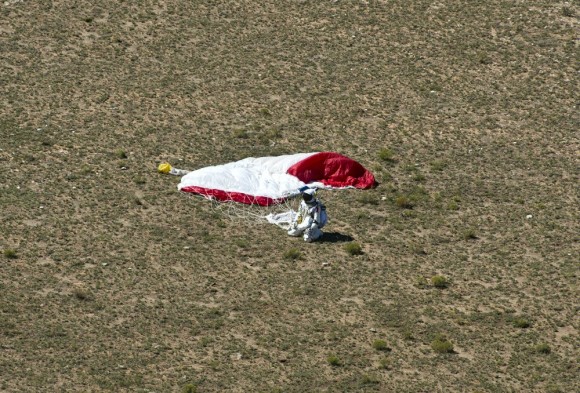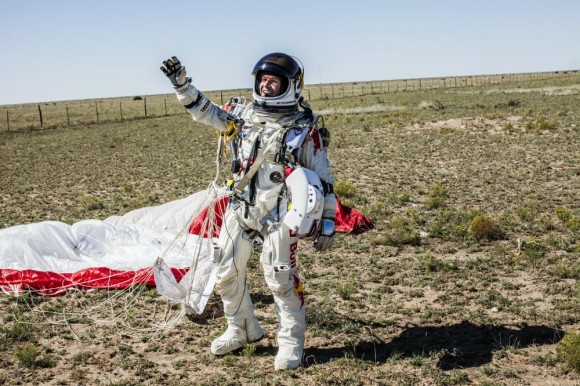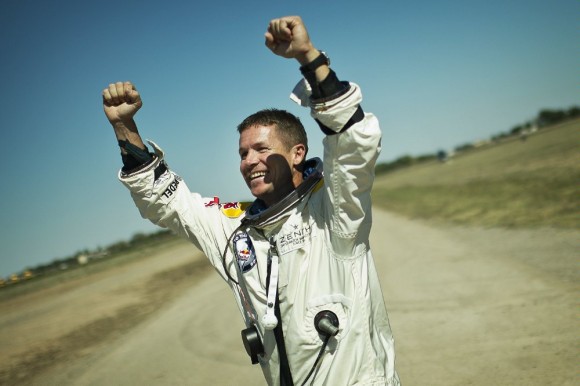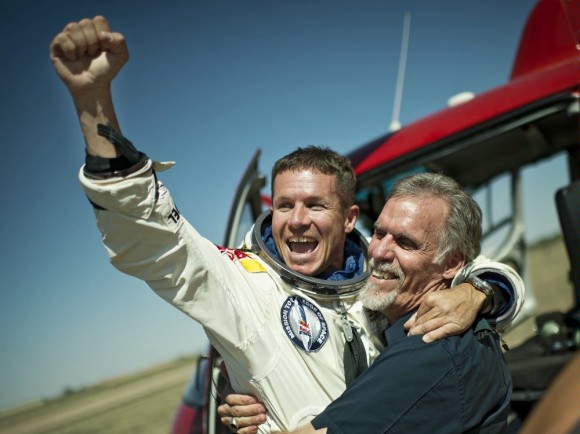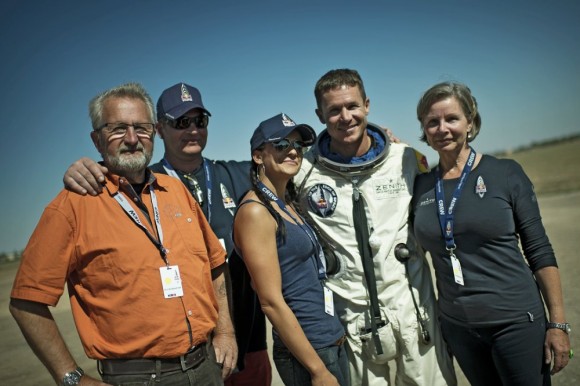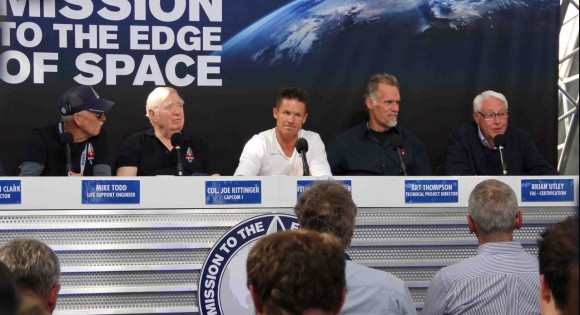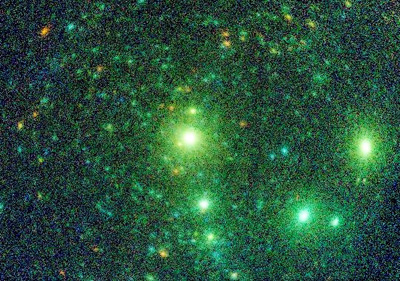Baumgartner’s Record-Breaking Jump: Images and Video
Pilot Felix Baumgartner of Austria jumps out of the capsule during the final manned flight for Red Bull Stratos in Roswell, New Mexico, USA on October 14, 2012. Credit: Red Bull Stratos.
Daredevil Felix Baumgartner broke the sound barrier today during a skydive from the stratosphere, from approximately 38.5 km (128,000 ft, 24.24 miles) above the Earth’s surface. Baumgartner reached Mach 1.24 or 1,342 km/h (833.9 miles per hour), going faster than the speed of sound.
The crane that holds the capsule as the balloon ascends. Credit: Red Bull Stratos.
The crane follows the balloon with the capsule at the flight line during the launch of Baumgartner’s flight. Credit: Red Bull Stratos.
Baumgartner seen on a screen at mission control center while he is still inside the capsule, while he talks to Joe Kittinger (back of his head is visible). Kittinger previously held the record for longest and fastest freefall before Baumgartner’s jump today. Credit: Red Bull Stratos.
Screens at the mission control shows Felix Baumgartner of Austria as he jumps from the capsule. Credit: Red Bull Stratos.
The view from a camera inside the capsule as Baumgartner jumps. Credit: Red Bull Stratos.
Baumgartner moves from his seat to the ledge outside the capsule. Credit: Red Bull Stratos.
Baumgartner floats down to Earth on a parachute. Credit: Red Bull Stratos.
Just before Baumgartner lands. Credit: Red Bull Stratos.
Baumgartner lands on his feet and celebrates. Credit: Red Bull Stratos.
Baumgartner falls to his knees after landing successfully. Credit Red Bull Stratos.
Felix Baumgartner celebrates after successfully completing his record-breaking jump. Credit: Red Bull Stratos.
Baumgartner after his successful jump. Credit: Red Bull Stratos.
Baumgartner and Technical Project Director Art Thompson celebrate together after the successful jump. Credit: Red Bull Stratos.
Baumgartner with members of his family following the successful jump. Credit: Red Bull Stratos.
Baumgartner, Kittinger and the Red Bull Stratos team at a press conference following the jump. Credit: Red Bull
What Happens When the Winds of Giant Stars Collide?
XMM-Newton observation of the core of the very massive cluster Cyg OB2 located in the constellation of Cygnus, 4700 light-years from Earth. Credit: ESA/G. Rauw
Two massive stars racing in orbit around each other have had their colliding stellar winds X-rayed for the first time, thanks to the combined efforts of ESA’s XMM-Newton and NASA’s Swift space telescopes. Stellar winds, pushed away from a massive star’s surface by its intense light, can have a profound influence on their environment. In some locations, they may trigger the collapse of surrounding clouds of gas and dust to form new stars. In others, they may blast the clouds away before they have the chance to get started.
Now, XMM-Newton and Swift have found a ‘Rosetta stone’ for such winds in a binary system known as Cyg OB2 #9, located in the Cygnus star-forming region, where the winds from two massive stars orbiting around each other collide at high speeds.
Cyg OB2 #9 remained a puzzle for many years. Its peculiar radio emission could only be explained if the object was not a single star but two, a hypothesis that was confirmed in 2008. At the time of the discovery, however, there was no direct evidence for the winds from the two stars colliding, even though the X-ray signature of such a phenomenon was expected.
Cyg OB2 #9 remained a puzzle for many years. Its peculiar radio emission could only be explained if the object was not a single star but two, a hypothesis that was confirmed in 2008. At the time of the discovery, however, there was no direct evidence for the winds from the two stars colliding, even though the X-ray signature of such a phenomenon was expected.
This signature could only be found by tracking the stars as they neared the closest point on their 2.4-year orbit around each other, an opportunity that presented itself between June and July 2011.
As the space telescopes looked on, the fierce stellar winds slammed together at speeds of several million kilometres per hour, generating hot plasma at a million degrees which then shone brightly in X-rays.
The telescopes recorded a four-fold increase in energy compared with the normal X-ray emission seen when the stars were further apart on their elliptical orbit.
“This is the first time that we have found clear evidence for colliding winds in this system,” says Yael Nazé of the Université de Liège, Belgium, and lead author of the paper describing the results reported in Astronomy & Astrophysics.
“We only have a few other examples of winds in binary systems crashing together, but this one example can really be considered an archetype for this phenomenon.”
Unlike the handful of other colliding wind systems, the style of the collision in Cyg OB2 #9 remains the same throughout the stars’ orbit, despite the increase in intensity as the two winds meet.
“In other examples the collision is turbulent; the winds of one star might crash onto the other when they are at their closest, causing a sudden drop in X-ray emission,” says Dr Nazé.
“But in the Cyg OB2 #9 system there is no such observation, so we can consider it the first ‘simple’ example that has been discovered – that really is the key to developing better models to help understand the characteristics of these powerful stellar winds. ”
“This particular binary system represents an important stepping stone in our understanding of stellar wind collisions and their associated emissions, and could only be achieved by tracking the two stars orbiting around each other with X-ray telescopes,” adds ESA’s XMM-Newton project scientist Norbert Schartel.
